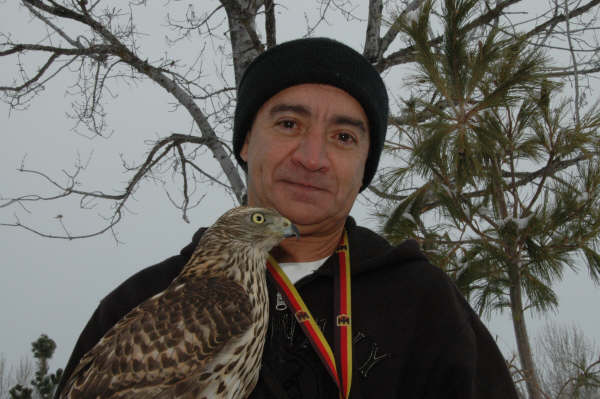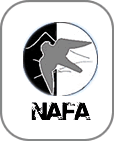Author: John Hein, Meridian Idaho

During December 2007 I hunted with a tiercel Finnish Goshawk. After getting a late start on the season, we worked as a team, bagging 17 ducks (15 drakes and 2 hens) and 2 hen pheasants. I named him Switchblade. He was quick and deadly. The 19 head of game were caught under extreme conditions of weather. Snow, rain and wind didn’t stop us. When he got pulled into the ditches, I would dive into the water after him. I did video record many unbelievable flights. After a kill, he was semi -cropped up, not gorged. On non -hunting days I would alternate conditioning and footing, using training methods that I used and developed.
In late June 2007, I picked him up in Boise, Idaho at the home of Jesse Woody, him for hours each day, as he rapidly grew up and became hard penned. I then started his training and physical conditioning, using a method that I had developed. He is a very handsome goshawk and his health is great. I have flown all of the large falcons, including Gyr/Prairie hybrid for 10 years. I have successfully worked with all of the North American accipiters, Harris’ Hawks, and Red-Tails. After forty years of experience I am still learning. I will share some of my experience with you. This tiercel Finnish Goshawk is one of the best birds that I have ever flown. He is a falconer’s dream. He is calm, and tame. His disposition is better than the North American goshawks that I have flown. He is the first Finnish goshawk that I have worked with. He will fly with groups and on lookers in great numbers without flinching. I do believe in good genetics. It takes a horse with championship genes to win races. Of course it also takes a good trainer and jockey to properly ride and control the horse. That’s basically all I did. I am convinced that they are born and bred that way. I called Jesse Woody and told him about the success I was having and how his speed and strength was like a switchblade. This would inspire me to name him Switchblade. I hunted creeks and unfrozen ponds. I wore a video camera around my neck with a braided rope. The most important garments that I had, were thermal underwear and a full diver’s wetsuit.
Many times the ducks would get up and would just fly just above the water for quite a distance. When they felt safe, they would dive back into the water in a quick “bail out”. These creeks and irrigation ditches are not what most falconers have to deal with. The creeks here are like mini Grand Canyons. They are carved from ten to fifty feet deep and 20 foot wide. Most have four or five feet of water from warm springs and they will go for miles. We always expect that the ducks will break out over dry land. Many local falconers said that they just would not leave the water, but think again. I flew my seasoned four year old North American Goshawk and the Finnish tiercel at the same time of day and gave both hawks an equal time to hunt. The training and conditioning for both hawks was the same. The N A goshawk (Queenie) was so frustrated, that at first, she would refuse flights at the ducks. She would catch a few, but not like Switchblade. I flew the hawks individually when hunting these ducks. The ducks would keep as low as possible when they were flushed. Unlike ponds or a regular creek, they would fly following the contour of the water, no matter how we flushed them. Unlike a pond, it was almost impossible to get them to fly out over dry land. They just flew hard and bailed out as soon as they felt safe.
I would even try dogs, only to have them fly over the dogs and follow the creek, about a foot above the water and then plunge back in. We would many times have to retrieve the dogs, because they could not get out of the deep ditches. Unless You have a secret weapon that the ducks have never seen before, in this case, a Finnish tiercel goshawk named Switchblade, they escaped. The very first outing, he saw the ducks and just watched as they flew off. He would just sit there on top of my glove, put one foot up, ruffle his feathers and look at them. They flew ,following the stream and plunged back in the water. The second time on the same day, at another location , a dozen or so got up and he caught one about a foot above the water, before it could get back into the creek. He had the hen Mallard with only one foot. It was so fast, I missed the flight. He was in the water with the duck. He held on to the struggling Mallard until I got in to the water and helped him. He actually would watch the duck’s escape tactics. Unlike my American female goshawk, who would get frustrated and would refuse ducks after a few flights, He became so good at it, that I would run up to a creek with a deep 45 degree angle embankment, slide fifty feet into the creek that was 4 feet deep and 10 feet wide. It seemed like a small Grand Canyon . I know, because I had to go in the water to retrieve him with a drake Mallard. as the ½ dozen ducks escaped. I flushed ducks from high above, looking down the fifty foot deep embankment only to have them fly away just above the water. He would fly down the 50 foot deep canyon as they were speeding away and catch a drake Mallard , about a foot above the water. After falling into the water, he bound to the duck and held on to it as I slid down the snowy embankment at a 45 degree angle 50 feet deep. There was about 4 feet of water in the creek. The temperature that day was 12 degrees ambient. I don’t know what the running creek water temp was as I retrieved him and duck. I actually caught this on video and showed this to the Idaho Falconers Meet held in Feb 2008. I have many videos of him on duck flights. He is just an immature hawk and not seasoned yet. What will he be as an adult? It was very hard to capture these flights on video. He truly is a Switchblade. He is bad news for ducks and pheasants. For a goshawk, he is very fast.
It was cold and snowing on January 6, 2008 when Switchblade became M.I.A.( MISSING IN ACTION ). It was fairly late in the afternoon and we were hunting in a new area. As we approached a long creek, about six mallards ten yards away, flew flushed , with Switchblade in hot pursuit. He disappeared around a curve in the creek and I briefly lost sight of him. I was walking about 75 yards away from where Switchblade landed in a small tree. I could see where he was. I heard what sounded like an air rifle or pistol fire 6 rapid shots. I then saw a feather pop off of the gos. It looked to me like he was shot in the chest and flew off. He went down like a injured bird not to far away in a housing track. As I pulled my self out of the creek and up to a small snow covered mound, I saw two youths with a pistol and what looked like a white canister type pistol. When I yelled at them to stop, they ran away. I attempted to run after them, but the rough, snowy terrain stopped me. At the same time, Switchblade flew down behind a property with a fence. It appeared that he was wounded. I immediately called the police and fish & game, to reported the situation. I let them know that I would be asking property owners to look for him. I began trying to locate his telemetry signal, It was in working order when I started the hunt. The property owners I asked were very polite and let me search. I wasn’t able to get a signal, so I guessed his body might be in the next property. I feared the worse, when he was not there either. I blew my whistle, shouted and threw my duck lure. After not getting any response, the weather got worse and darkness forced me to stop looking. The next day, I went out early and looked and blew my whistle. I yelled out for him and threw the duck lure again. I kept asking myself what happened to the transmitter. Did it get hit from the shots or did the transmitter just fail. Were the batteries good? I always put in fresh batteries. After years of flying and using telemetry, what happened? I wanted to have closure. I wanted to know if he was dead or alive. Would he suffer and die later from the gun shot. I sent an e-mail to the Idaho Falconers association and offered a five hundred dollar reward. Jesse Woody, past president of the IFA, even took time out to help me look for him. Jesse is the breeder of Switchblade. THANK YOU JESSE FOR HELPING ME.
Cold weather conditions and record breaking snow fall in the coming days made it difficult. But, I looked every day, thinking that he was dead and covered by snow. Two days later I got a call from Jesse Woody, and the Idaho Fish and Game Dept. Bruce Haak left a message at my Home and Jesse called me on my cell phone reporting that someone watched a hawk eating a chicken at a local farm. When I received the information, I immediately headed over to the location, It sounded like a good sighting. When I arrived, the property owner said the girls saw the hawk fly off . It was not to far from where he was shot. The chicken that was killed, was very large and the witness were two young girls (12 and 10 Years old) . For the next 5 days I looked every day at every hour. I received a call one night after 10.00 pm and the land owner from the first report said my bird had killed another one of his chickens was eating it. The girls said that it was the same bird that did the first one in. I told them I would buy them more chickens if it was him. I rushed over there at 10.15pm in the dark. What I found was a beautiful female Great Horned Owl eating a huge dead chicken. It was about 30 feet away as I saw her with my flashlight . The days were passing fast and I finally gave up my search after 10 days. It was another 10 days later (total 20 days), when I ran out of groceries and food to eat. I headed out with my 4 WD truck on the icy back roads to shop at Wal-Mart. The roads were blocked every where with construction going on. I had to take a detour at approximately 3 miles from where I last saw him. I went down an ice packed road , as snow began to fall. As I’m driving a long, I noticed some large leafless trees along a creek. In a tree about 250 yards off of the road I saw a small speck that looked like a hawk. I pulled to the side of the road and scanned the trees with my binoculars. It was hard to see through the falling snow. This was about 5 miles from my house. I then parked and went walking through knee deep snow. I made sure that I had my hunting bag, lure and binoculars. It was very cold as I walked about 125 yards. When I stopped and scanned the tree top, all I saw was a crow. How could I be wrong, and walked all the way out there? I started walking back to my truck with my head down in the blowing snow and with wind freezing my face . I was about half way back to my truck when I was startled by something grabbing my left shoulder. I flinched big time. It scarred me and I dropped my blue hawking bag that I carry everything in. When I turned and looked, to my amazement and excitement it was Switchblade. My sudden movements scared him off of my shoulder. He then circled around and landed in the snow 15 feet away. I said, out loud, its you. You are alive, it’s a miracle. He was just landing on my shoulder as he always did . He did this in the field when we missed game. I reached in my bag grabbed a glove. He stepped up to my glove I gave him a kiss on top of his head. He made a vocal sound I never heard him make before. He was always quiet because of how I raised him. I guess maybe he missed me . I noticed he had no transmitter on his leg mount. It was gone and it is still a mystery . Form now on, 2 transmitters and 2 of everything, including receiver. I called Jesse with the great news and he was very excited for me. I took him home, riding on my fist. I brought him in and weighed him at 760 grams with empty crop. I had been flying him at 710 grams. He was hunting out there. It could have been rats or squirrels. His feet had bite marks and he had gained weight. I offered him food and he was not hungry. I then checked him out and saw no marks like a gun shot anywhere on his body. I noticed one of his tail feathers, 1 inch up, was missing. I assumed that is the feather that I saw when this happened, 20 days ago. I then gave him his bath water in the house. He jumped in and immediately took a bath and drank. I took him to a vet. After talking with the veterinary clinic, we decided to wait and not put him under for a check up. After all 20 days of weight gain, he looked good. As I typed this article, Switchblade is looking at me with one foot up and head up side down . I look forward to the next season with Switchblade, Its all in the genetic make up that he was born and bred this way. Of course you have to do your part. He is still a goshawk. He is tough. I believe he was fighting and defending himself from all of the predators that he encountered. He had to hunt and kill to survive and take care of himself. WHAT A FINNISH GOSHAWK.
I want to thank, Bruce Haak and Kim Cox from Idaho Fish and Game, also Idaho Meridian Police Dept. Officer Leroy Sunada for their help. And Jesse Woody, the breeder of this magnificent goshawk. Thank you very much.


